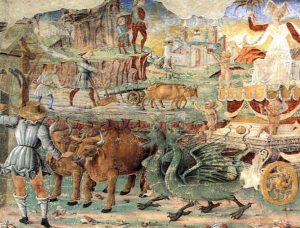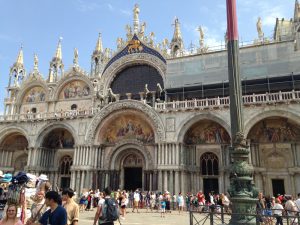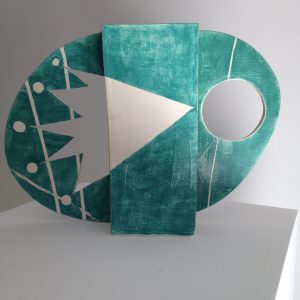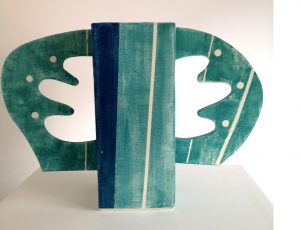Ledbury’s surreal connections
There is a lot of doc leaf in the fields and meadows at this time of year – they turn a dark ox blood red as their seeds appear and are easily identified as they stand out in the green landscape. This is very noticeable walking up the hill to Bradlow Knoll. The reason they command the eye’s attention is that we humans find red on green, or green on red, a very strong and vigorous combination – both colours are opposites on the colour chart, as blue is to orange, or yellow to violet, though these do not have the same force.
Interestingly, blue, red, and yellow are primary colours, whereas green is not (being made of yellow and blue) but has the personality of a primary colour. Anyway, try putting a piece of pure green paper next to a central red (one that pulls nether to yellow or to blue) and you might see the edge where they meet seemingly vibrate.
This is what goes through one’s head when walking up a hill towards a wood, this and “did I switch the kiln on?”, and “how do birds pee?”, and “which would be the nicest if animals could talk?” Once on top of the hill, the view below, with Ledbury’s steeple in the mid-distance, turns one’s attention in another direction.
Ledbury has become a popular destination for visitors recently, or it could be that they are all “passing through” on their way to Wales. Nevertheless, seeing the place where you live through the eyes of a stranger is good – what you usually accept as commonplace is often special when looked at objectively. For example, it really is extraordinary that so small a place has such links with poets such as Masefield, Barrett Browning, Auden, Frost and Thomas, or that Butchers Row museum once stood in the middle of the High Street with seven others buildings and saw the slaughter of animals on a regular basis, the blood and effluvia mingling with the stream that ran down Church Lane leading to outbreaks of typhoid – until the buildings were bought out by public subscription and knocked down.
Though Ledbury is no stranger than any other place, it does exhibit a Tibetan flute or pipe fashioned from the thigh bone of a human, it did have church sextons who carried long sticks to wake up those who were nodding off with a tap on the head, and it did have pavements made of large cobbles or “petrified kidneys” that were big enough to send clog-wearing Ledburians flying.
So, Ledbury has its “surreal” moments, but few places can boast of being the birthplace of a true surrealist painter like Conroy Maddox. He was born in 1912, upstairs in what is now the Herefordshire Wildlife Trust shop, next door to the Poetry House on the corner of Bye Street. A painter, collagist, writer and lecturer; he discovered surrealism in 1935, spending the rest of his life exploring its potential through his paintings, photographs, objects and texts. He rejected academic painting in favour of techniques that expressed the surrealistic spirit of rebellion.
His creations soon began not only to challenge the conventional view of reality, but also to push pictorial expression to the limits of consciousness. He was even implicated in both scandal and controversy when, during the Second World War, Scotland Yard suspected him of fifth columnist sabotage and mounted a surprise raid to seize works thought to contain coded messages to the enemy.
Weekend parties at Maddox’s house drew in a wide variety of unconventional attendees, and guardian journalist Tim Hilton recalled in his obituary of the artist: “Festivities were common in Maddox’s surrealist villa. I attended carousals there with other undisciplined children, women in Gypsy dress, poets, communist intellectuals from the University of Birmingham, and early postwar Caribbean immigrants … The Balsall Heath house also contained dozens of unsold paintings and many photographs of Maddox in the company of a nun. Some of their activities involved a crucifixion, the naked but bespectacled Maddox its victim, while the nun drank from a two-pint bottle of the local brew, Mitchell’s and Butler’s.”
The obvious link between ceramics and surrealism is Marcel Duchamp’s inverted porcelain urinal signed “R.Mutt” and titled “Fountain.” Sadly, this will not be on show during Herefordshire Art Week, a nine-day art trail open to all (3 – 11 September). Artists, craft makers and creative businesses open their private studios every day from 11am – 5pm.
The Take Four Gallery on the High Street will be exhibiting some pieces by Peter Arscott Ceramics, and there will be demonstrations at 11 and at 2 on Thursday 8th September on how to make a three-legged urinal, er..sorry…bowl.
h.Art has become part of Herefordshire’s cultural calendar, with a huge variety of art and art forms on show in open studios, group exhibitions and gallery events. The vast majority offer free admission to visitors, in locations such as manor houses, historic barns, farms, churches and beautiful gardens.
Back in the cool of Frith Wood, with no other walkers on a very early Monday morning, the eery silence was only occasionally broken by birdsong, and at one point a sudden crashing through the undergrowth revealed the light brown back of a fleeing deer. If Surrealism was an avant-garde movement in art and literature which sought to release the creative potential of the unconscious mind, for example by the irrational juxtaposition of images, then this was a good setting – substitute pike for deer.
From predatory pike to printed prose: let me introduce you to the Stand Magazine and to Jon Silkin, poet, editor and critic who established it with his £5 redundancy money (received after trying to organise some of his fellow manual workers) as a ‘stand’ against injustice and oppression, and to ‘stand’ for the role that the arts, poetry and fiction in particular, could and should play in that fight.
As described by the poet Rodney Pybus, Stand is “….. a place where the unglamorous, the unfashionable, the oppositional, the innovative, the unEnglish, the radical voices might gain a hearing as well as the more conventional, acceptable and consensual voices.”
My short story, Maxwell’s Nose, probably belongs to the “conventional, acceptable and consensual” stable. If you’d like to read it you can click here for the website, and you can read the intro, though you would have to buy an individual copy (£7 inc postage) through the editor at engstand@leeds.ac.uk to read the whole story, or else subscribe online. Excellent poetry contributions.







































